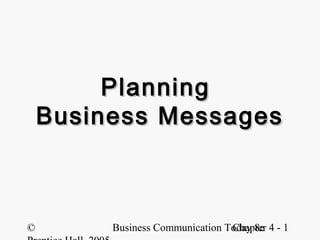More Related Content More from Jayati Poddar (11) 1. Planning
Business Messages
© Business Communication Today 8e 4 - 1
Chapter
2. Three-Step Writing
Process
• Planning
• Writing
• Completing
© Business Communication Today 8e 4 - 2
Chapter
4. Analyze the Situation
• Define your purpose
• Profile your audience
© Business Communication Today 8e 4 - 4
Chapter
5. Define Your Purpose
• General • Specific
– Inform – Realism
– Persuade – Timing
– Collaborate – Delivery
– Acceptability
© Business Communication Today 8e 4 - 5
Chapter
6. Test Your Purpose
1. What will your message change?
2. Is your purpose realistic?
3. Is the timing right?
4. Is the right person delivering it?
5. Is your purpose acceptable?
© Business Communication Today 8e 4 - 6
Chapter
7. Profile Your Audience
• Identify primary audience
• Determine size
• Determine composition
• Gauge level of knowledge
• Project expectations and preferences
• Estimate probable reaction
© Business Communication Today 8e 4 - 7
Chapter
8. Gather Information
• Informal methods
– Viewpoints of others
– Reports and company documents
– Supervisors, colleagues, customers
– Audience input
© Business Communication Today 8e 4 - 8
Chapter
9. Provide Information
• Be sure information is accurate
• Be sure information is ethical
• Be sure information is pertinent
© Business Communication Today 8e 4 - 9
Chapter
10. Selecting the Right
Medium
• Oral
• Written
• Electronic
© Business Communication Today 8e 4 -
Chapter
11. Analysis of Oral Media
• Advantages
– Immediate feedback
– Ease of interaction
– Rich nonverbal cues
– Emotional content
• Disadvantages
– Restricted participation
– Nonpermanent
– Reduced control
– No editing or revision
© Business Communication Today 8e 4 -
Chapter
12. Analysis of Written Media
• Advantages
– Planning and control
– Permanent record
– Wide audience
– Minimize distortion
• Disadvantages
– Delayed feedback
– Lacks nonverbal cues
– Creation and distribution
– Preparation and production
© Business Communication Today 8e 4 -
Chapter
13. Electronic Media
• Voice mail • Faxing
• Teleconferencing • E-mail
• Videotape • Instant messaging
• Computer • Websites
conferencing
© Business Communication Today 8e 4 -
Chapter
14. Advantages
of Electronic Media
• Delivery speed
• Audience reach
• Multimedia
• Accessibility
© Business Communication Today 8e 4 -
Chapter
15. Disadvantages
of Electronic Media
• Tension or conflict
• Overuse
• Privacy issues
• Productivity
© Business Communication Today 8e 4 -
Chapter
16. Continuum
of Media Richness
• Media richness
– Leaner
• Fliers, bulletins, and reports
– Richer
• Conversations, meetings, presentations
© Business Communication Today 8e 4 -
Chapter
17. Choosing the Right Media
• Message formality
• Media limitations
• Sender intentions
• Urgency and cost
• Audience preferences
© Business Communication Today 8e 4 -
Chapter
18. Organizing Messages
• Get to the point
• Omit irrelevant details
• Use logical groupings
• Indicate relevant ideas
© Business Communication Today 8e 4 -
Chapter
19. Why Is Organization
So Important?
• Improves productivity
• Boosts understanding
• Increases acceptance
• Saves audience time
© Business Communication Today 8e 4 -
Chapter
20. Define the Main Idea
1. General purpose
2. Specific purpose
3. Basic topic
4. Main idea
© Business Communication Today 8e 4 -
Chapter
21. Generating Ideas
• Brainstorming
• Mapping
• Storyteller’s tour
• Journalistic approach
• Question-answer chain
© Business Communication Today 8e 4 -
Chapter
22. Limiting the Scope
• Time and space
• Number of main ideas
• Audience attitude
• Depth of research
© Business Communication Today 8e 4 -
Chapter
23. Sequencing the Message
• Direct approach
– Deductive
• Indirect approach
– Inductive
© Business Communication Today 8e 4 -
Chapter
24. Classifying Messages
Message Audience Type of
Type Reaction Approach
Routine, Good-News Pleased Direct
or Good Will Or Neutral
Bad News Displeased Indirect
Uninterested
Persuasive Indirect
or Unwilling
© Business Communication Today 8e 4 -
Chapter
25. Constructing Outlines
Alphanumeric Decimal
I. First Major Part 1.0 First Major Part
A. First subpoint 1.1 First subpoint
B. Second subpoint 1.2 Second subpoint
1. Evidence 1.2.1Evidence
2. Evidence 1.2.2Evidence
A. Third subpoint 1.2.3 Third subpoint
II. Second Major Point 2.0 Second Major Point
A. First subpoint 2.1 First subpoint
B. Second subpoint 2.2 Second subpoint
© Business Communication Today 8e 4 -
Chapter
26. Charting Organizations
The Main Idea
I. Major Point II. Major Point III. Major Point
A. Evidence A. Evidence A. Evidence
B. Evidence B. Evidence B. Evidence
C. Evidence C. Evidence C. Evidence
© Business Communication Today 8e 4 -
Chapter
Editor's Notes Once you have defined your specific purpose, you can decide whether that purpose merits the time and effort required for you to prepare and send it. Test your purpose by asking five questions: Will anything change as a result of your message? Is your purpose realistic? Is the time right? Is the right person delivering the message? Is your purpose acceptable to the organization? Once you are satisfied (1) that you have a clear and meaningful purpose and (2) that now is a smart time to proceed, your next step is to understand the members of your audience and their needs.

